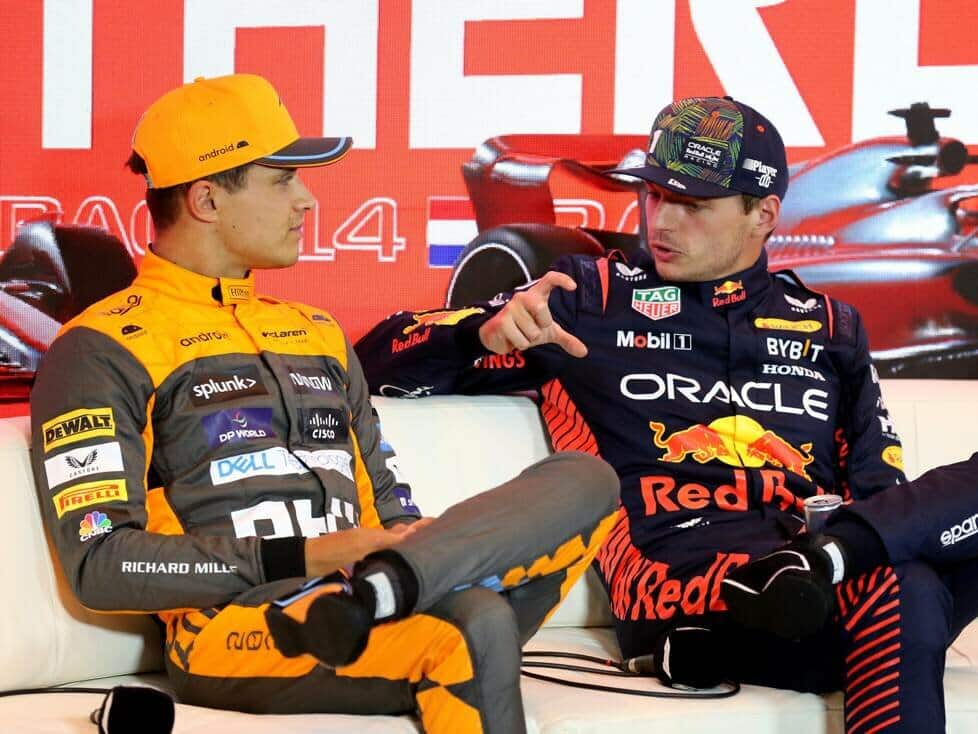Analysis of the GPS data shows that Lando Norris was on pole course until turn 7 and what weaknesses the McLaren MCL60 currently still has
Max Verstappen has secured pole position at his home race in Zandvoort, much to the delight of the frenetically cheering crowd. The Red Bull driver’s lead in the end was 0.527 seconds. Only twice this season – in a treacherous shootout on a wet track in Canada and most recently at Spa-Francorchamps before he had to serve a gearbox penalty – has he been further ahead.
With Charles Leclerc crashing and Red Bull teammate Sergio Perez 1.313 seconds off Verstappen’s best time of 1:10.567, it was left to Lando Norris to complete the front row and double underline McLaren’s turnaround. He edged out Mercedes driver George Russell in a head-to-head battle to secure the second grid spot for the 2023 Dutch Grand Prix.
But shortly after his jubilation – and after noting how rarely Verstappen makes a mistake that opens the door for rivals – Norris complained about “one of the worst second halves [of a lap] I’ve ever driven”. He said the first part of his Q3 lap was “mega” before “the driver” (and not the tyre) “peaked” too early.
The GPS data, read out via F1-Tempo.com, shows that Norris was right to praise the first part of his lap. On the 14-turn Zandvoort lap, the McLaren driver was faster than Verstappen until turn 7. By 0.037 seconds in the first sector.
After the RB18’s efficiency again made itself felt on the straight, with Verstappen entering the braking zone of Turn 1 with 3.7 km/h more, Norris reached the first apex some 6.8 km/h quicker and was up to 0.185 seconds ahead. The Red Bull battled back through Turn 2 at a higher speed, but the McLaren driver still led by 0.083 seconds.
Norris then began to extend his lead of almost 0.2 seconds again through the banked Turn 3. This fast run through a tighter corner, similar to the first corner, reflected the gain in downforce McLaren had made with its three-stage upgrade package.
Top speed: one of the Red Bull’s strengths
On the following straight, however, the Red Bull’s performance at top speed came into play again, allowing Verstappen to close in on Norris. The gap dropped to 0.069 seconds, but still remained in Norris’ favour until turn 7.
Verstappen’s higher exit speed at turn 7 allowed him to get ahead of Norris. From this point of their final Q3 laps, the two-time defending champion stayed ahead. But the McLaren was only 0.058 seconds behind going into the similarly long, medium-fast Turn 8.
While the MCL60’s downforce has been improved by the extensive updates, its mid-corner consistency is still a relative weakness. The team has noticed all season that the chassis struggles in situations where the throttle is taken away and with changing loads in longer corners. This is evidenced by the fact that Norris was already 0.141 seconds behind at turn 8.
In turn 9, the gap remained at 0.1 seconds, but then doubled. In the tight turn 11 at the bottom of the back straight, the gap increased to 0.3 seconds. This can be explained by a driving mistake.
At the exit of turn 10, Norris accidentally double shifted. He jumped from third to fifth gear. Instead of losing more time by shifting again to correct this, he held fifth gear and waited for sixth. Verstappen, meanwhile, pulled the gear lever for fourth gear and did not suffer the same loss of revs (around 2,000 rpm). As a result of this mistake, Verstappen was temporarily 7.5 km/h faster on the way to turn 11.
The GPS data shows: Until after turn 7, LandoNorris had a lead of up to 0.185 seconds over Verstappen at times. But from the shifter in turn 10, Verstappen pulled up and away. DutchGP F12023 F1 Formula1 via @f1_tempo_ pic. twitter.com/NQ1RVgqlZM
– Christian Nimmervoll (@MST_ChristianN) August 27, 2023
The gap between the two widened to 0.433 seconds in Verstappen’s favour on the short run to the banked double corner that closes the lap. While Norris reached a higher top speed here and took the first apex quicker, he couldn’t hold a candle to the RB18 on the way to the finish line. That helped Verstappen to his eventual lead of 0.527 seconds.
McLaren knows pole just wasn’t in it
McLaren team boss Andrea Stella and Norris are clear that pole position was out of reach. Even without the double shift error, the MCL60’s inconsistent handling in longer corners and its gap to the RB18 on the straights was too much to overcome.
Nevertheless, Verstappen helped himself by achieving his ideal lap time in the end. On his final flying lap in Q3, he stitched together his three best sectors. On paper, Norris did not make the most of his opportunities. The data shows that he dropped 0.056 seconds. He clocked 24.818 in the second sector instead of his personal best of 24.874 seconds.
Had Norris at least equalled his previous time in the middle sector, he would have set a best time of 1:11.048 minutes and reduced the gap to Verstappen to 0.481 seconds. However, given the drying conditions in qualifying, this does not take into account the increased level of track development on the dusty track.
The Q3 contenders who completed a similar plan to Norris (Verstappen, Russell and Perez), namely to complete two fast laps, found an average of 0.237 seconds in the middle sector between their first and second flying laps.
It’s an inaccurate measurement, but if Norris, instead of losing time in the second sector, had matched the average and gained just over two tenths of a second, his lap time would have dropped to 1:10.811. This would have theoretically reduced his gap to Verstappen to 0.244 seconds.

